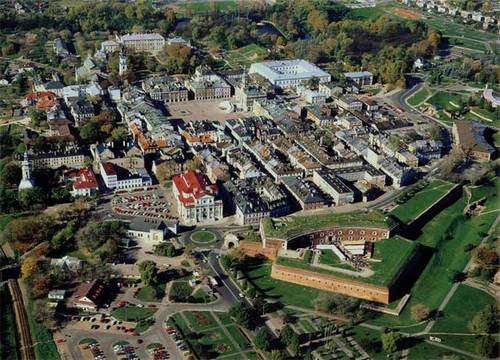Coming soon
dal 16/6/2006 al 17/8/2006
Segnalato da
16/6/2006
Coming soon
Different venues, Zamosc
In just one month opens the first manifestation of Ideal City-Invisible Cities. 41 international artists will reflect from June 18 onward the ideal city and its sibling, the invisible city in Zamosc, Poland. The artists working site-specifically will react to the given architecture and insert their work in public spaces and buildings, hidden courtyards or squares.

In just one month opens the first manifestation of Ideal City -Invisible Cities. Fortyone international artists will reflect from June 18 onward the ideal city and its sibling, the invisible city in Zamosc, Poland:
Tarek Al-Ghoussein, Francis Alys, Carl Andre, Archigram, Colin Ardley, Tim Ayres, Miroslaw Balka, Daniela Brahm, Pedro Cabrita Reis, Rui Calcada Bastos, Constant, Jonas Dahlberg, Tacita Dean, Jaroslaw Flicinski, Carlos Garaicoa, Dan Graham, George Hadjimichalis, Rula Halawani, Franka Hoernschemeyer, Craigie Horsfield, Katarzyna Jozefowicz, Jakob Kolding, Ola Kolehmainen, Lucas Lenglet, Sol LeWitt, David Maljkovic, Gerold Miller, Matthias Mueller, Teresa Murak, Brian O’Connell, Daniel Roth, Albrecht Schaefer, Kai Schiemenz, Les Schliesser, Melanie Smith, Monika Sosnowska, David Tremlett, Anton Vidokle, Lawrence Weiner, Tilman Wendland, Krzysztof Zielinski
Curated by Sabrina van der Ley and Markus Richter / European Art Projects
Commissioner: Anda Rottenberg, Adam Mickiewicz Institute
Zamosc is an extraordinary treasure of late Renaissance architecture singular in its urban conception, located near the Polish-Ukrainian border, on route between Lublin and Lwow. The never destroyed city will host the works of contemporary artists from twelve European and six non-European countries amidst its traces of a once truly multicultural society, the former orthodox churches, the cathedral, the synagogue as well as the Armenian houses.
Only few ideal cities were ever partially or completely built. In particular, the ideal city plannings that were closely tied to societal utopias usually remained unrealized. Zamosc, conceived by Count Jan Zamoyski and built between 1580 - 1605 by Italian architect Bernardo Morando, is one of the rare existing examples of an ideal city. Today Zamosc is included in the UNESCO list of World Heritage.
The artists working site-specifically will react to the given architecture and insert their work in public spaces and buildings, hidden courtyards or squares. Lawrence Weiner enfolds the arcades at the main square with one of his word sculptures. Monika Sosnowska composed a fountain while Miroslaw Balka sculpture relates to wounds, deeply cut during the second World War. Daniela Brahm, Colin Ardley, Kai Schiemenz determine squares and public spaces anew, Franka Hoernschemeyer reflects with her installation the clear gridding of the city’s layout and Lucas Lenglet drafted a columbarium for one of the courtyards. Les Schliesser sets up a museum for a fictive architect born in Zamosc, Jakob Kolding investigates functional city planning with a poster project and Craigie Horsfield introduces a sound installation. David Tremlett inserted pastel wall drawings into the cartouches of the Renaissance synagogue, while the structural works of Katarzyna Jozefowicz and Pedro Cabrita Reis d ialogue across its naves and Sol Lewitt inhabits its courtyard temporarily. Tilman Wendland’s installation in the historical museum will integrate documentation on ideal city plans of the moderns Le Corbusier, Niemeyer and Hansen and Jaroslaw Flicinski will conceive a large wall painting for the academy, in the gymnasium of which George Hadjimichalis will install his Workshop of Projects and Images in Crisis.
In the casemates of the decorates fortress Zamosc, the photo, film and video works by Tarek Al-Ghoussein, Francis Alys, Tacita Dean and Rula Halawani address the issues of geometry, order, defence systems, resistance and alleged security. In the historical academy building, which today houses the town’s high school, in the Historical Museum and at the Zamosc City Gallery 20 artists will be showing their works relating to the major themes of the exhibition including memory and the grid. The contemporary art works will engage in a challenging and substantial discourse with the historical city and the underlying invisible cities, hidden beyond or masked by time and history.
All in short walking distance, the exhibition will cover the entire city of Zamosc from June 18, 2006 to August 22, 2006. In September and October, a freshly adapted version of the exhibition will be shown in the city of Potsdam, which was mainly planned and built during Baroque times.
Ideal City - Invisible Cities is funded by the German Federal Cultural Foundation.
Further generous support is kindly provided by the Adam Mickiewicz Institute, Warsaw and the City of Zamosc. Additional funds thanks to ifa-Institute of Foreign Relations, Stuttgart; the Mondriaan Stichting, Amsterdam, the Instituto das Artes, Lisbon; the Gulbenkian Foundation, Lisbon; the Luso-American Foundation, Lisbon and the Ford Foundation, Cairo.
Project Partners: City of Zamosc; BWA Zamosc; Museum Zamoyski, Zamosc; Foundation for the Preservation of Jewish Heritage in Poland; Art School of Zamosc, College of Management and Administration, Zamosc; Brandenburgischer Kunstverein, Potsdam; Kulturland Brandenburg e.V.; Filmmuseum Potsdam, Haus der Brandenburgisch-Preussischen Geschichte, Greige - Buero fuer Design.
For images and further information please view the web site or contact Anne Maier at European Art Projects, Tel. +49-30-30 38 18 37, Fax +49-30-30 38 18 30.



